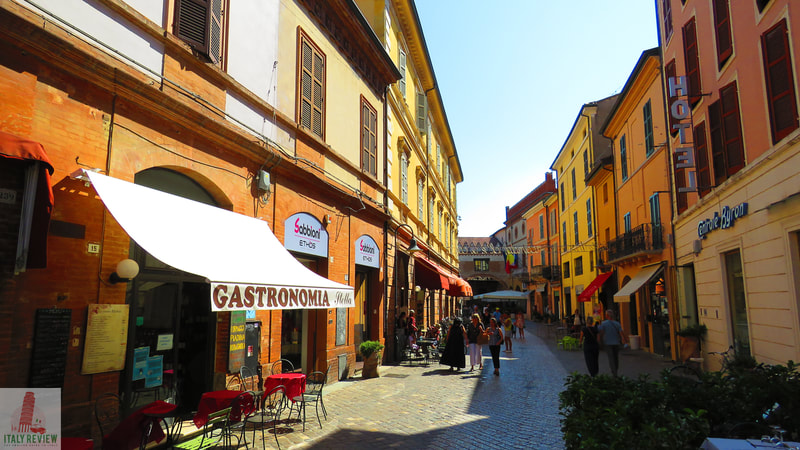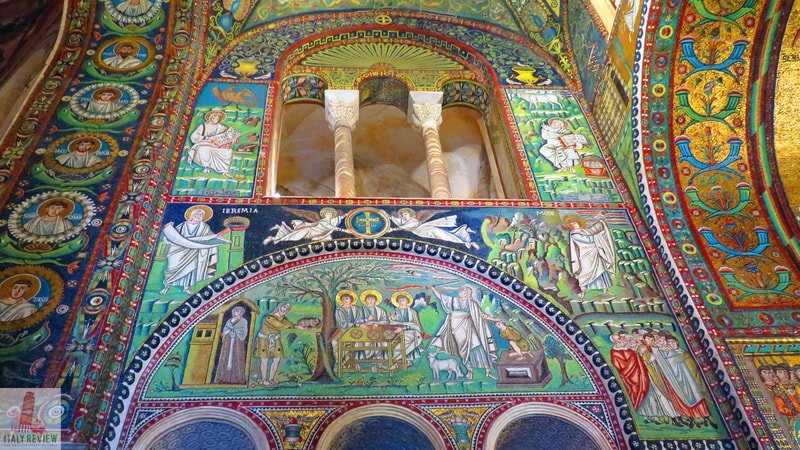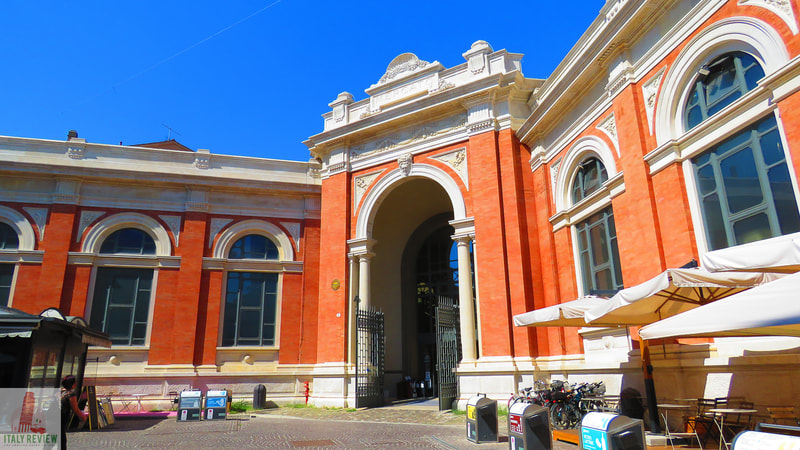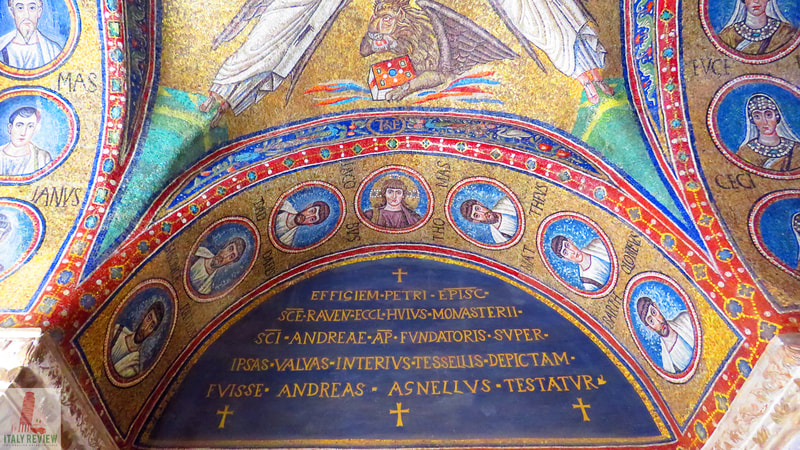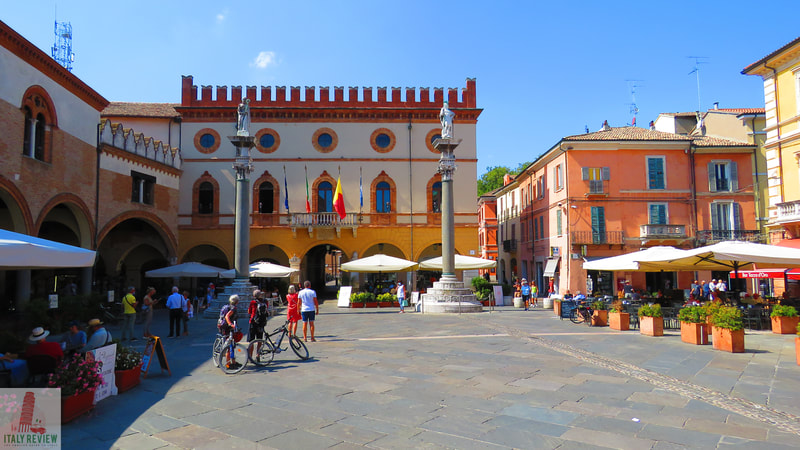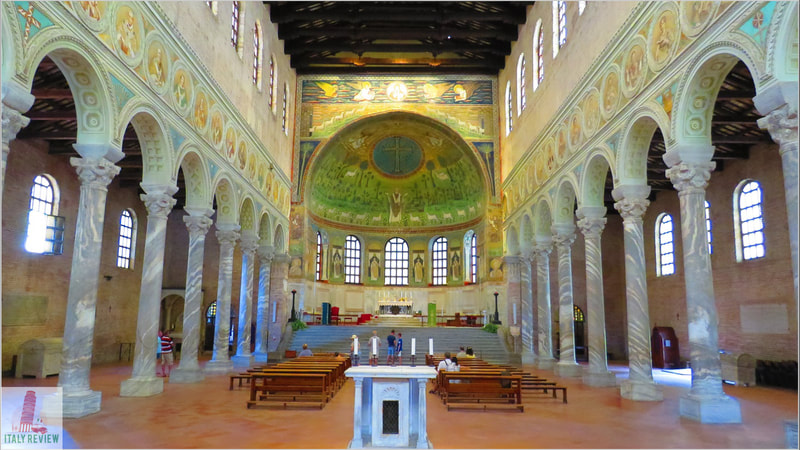Ravenna
|
By Dion Protani
|
Latest update: 30 December 2023
|
|
The city of Ravenna is the capital city of the Province of Ravenna with a population of 157,663 inhabitants.
Situated 11 kilometres inland of the Adriatic coast, it covers a total area of 653 km² and lies 80 kilometres east of Bologna, the regional capital of Emilia Romagna. The one time capital of the Western Roman Empire, Ravenna is one of the most historic cities in Italy and is particularly renowned for its numerous examples of Byzantine art, particularly its mosaics. |
Related links
Early Christian Monuments of Ravenna - Byzantine mosaics
It is to this legacy of art and architecture that Ravenna owes its UNESCO World Heritage listing. Included under the heading "Early Christian Monuments of Ravenna", the city was added to the UNESCO list in 1996. There are eight buildings in the list and most, but not all, can be visited on foot from the city centre.
The full list of UNESCO-listed monuments in Ravenna is as follows: Basilica di San Vitale, the Mausoleum di Galla Placidia, the Neonian Baptistery, Basilica di Sant'Apollinare Nuovo, the Arian Baptistery, the Archiepiscopal Chapel, the Basilica di Sant'Apollinare in Classe and the Mausoleum of Theodoric.
It is to this legacy of art and architecture that Ravenna owes its UNESCO World Heritage listing. Included under the heading "Early Christian Monuments of Ravenna", the city was added to the UNESCO list in 1996. There are eight buildings in the list and most, but not all, can be visited on foot from the city centre.
The full list of UNESCO-listed monuments in Ravenna is as follows: Basilica di San Vitale, the Mausoleum di Galla Placidia, the Neonian Baptistery, Basilica di Sant'Apollinare Nuovo, the Arian Baptistery, the Archiepiscopal Chapel, the Basilica di Sant'Apollinare in Classe and the Mausoleum of Theodoric.
Basilica di San Vitale and around
The main square in Ravenna is Piazza del Popolo, an elegant square built in the 15th century by the Venetians with porticoed sides and two distinctive columns which honour the city's patron saints: Saint Apollinaris and Saint Vitalis. Using Piazza del Popolo as a starting point, it's a 6 minute walk (500 metres) to the first of the city's most important sights: the Basilica di San Vitale.
Built in the 6th century by the Ostrogoth king Theodoric, the Basilica di San Vitale is home to a breathtaking array of Byzantine mosaics and other artwork. It's also just a few steps from here to the Mausoleo di Galla Placidia, a small mausoleum with further mosaics which are among the most famous in the city. The San Vitale complex is completed by the National Museum of Ravenna and the Chiesa di Santa Maria Maggiore; all of which are situated in the same small area.
The main square in Ravenna is Piazza del Popolo, an elegant square built in the 15th century by the Venetians with porticoed sides and two distinctive columns which honour the city's patron saints: Saint Apollinaris and Saint Vitalis. Using Piazza del Popolo as a starting point, it's a 6 minute walk (500 metres) to the first of the city's most important sights: the Basilica di San Vitale.
Built in the 6th century by the Ostrogoth king Theodoric, the Basilica di San Vitale is home to a breathtaking array of Byzantine mosaics and other artwork. It's also just a few steps from here to the Mausoleo di Galla Placidia, a small mausoleum with further mosaics which are among the most famous in the city. The San Vitale complex is completed by the National Museum of Ravenna and the Chiesa di Santa Maria Maggiore; all of which are situated in the same small area.
Ravenna Cathedral
At the opposite end of the city centre and a ten minute walk (750 metres) from the San Vitale complex lies another important area of sightseeing. At the centre of these sights is Ravenna Cathedral which is flanked by the Neonian Baptistery. Behind the cathedral is another UNESCO site, the Archiepiscopal Chapel which is housed within the eponymous museum (Museo Arcivescovile).
At the opposite end of the city centre and a ten minute walk (750 metres) from the San Vitale complex lies another important area of sightseeing. At the centre of these sights is Ravenna Cathedral which is flanked by the Neonian Baptistery. Behind the cathedral is another UNESCO site, the Archiepiscopal Chapel which is housed within the eponymous museum (Museo Arcivescovile).
Museo Dantesco
Most of the remaining sights within the city centre are more spread out. Heading north east from the cathedral for 4 minutes (350 metres) you come to Dante's Tomb and the Museo Dantesco. Legendary Italian poet Dante Alighieri wrote his masterpiece The Divine Comedy whilst he saw out the last of his days in Ravenna, having been exiled from his native Florence. The neoclassical building that houses his tomb was built in the 18th century while the Museo Dantesco displays memorabilia in celebration of his life.
Most of the remaining sights within the city centre are more spread out. Heading north east from the cathedral for 4 minutes (350 metres) you come to Dante's Tomb and the Museo Dantesco. Legendary Italian poet Dante Alighieri wrote his masterpiece The Divine Comedy whilst he saw out the last of his days in Ravenna, having been exiled from his native Florence. The neoclassical building that houses his tomb was built in the 18th century while the Museo Dantesco displays memorabilia in celebration of his life.
Basilica di Sant'Apollinare Nuovo and Arian Baptistery
Continuing on foot, 6 minutes east from the Museo Dantesco you reach one of the major sights in the city: the Basilica di Sant'Apollinare Nuovo which was, along with the Basilica di San Vitale, built in the 6th century by Theodoric. Inside the basilica you'll find some of the best mosaics in the city, rivalling those already mentioned at the locations above. From the Basilica di Sant'Apollinare Nuovo it's a 5 minute walk (350 metres) to the Arian Baptistery which is another building housing an extraordinary collection of Byzantine mosaics.
Continuing on foot, 6 minutes east from the Museo Dantesco you reach one of the major sights in the city: the Basilica di Sant'Apollinare Nuovo which was, along with the Basilica di San Vitale, built in the 6th century by Theodoric. Inside the basilica you'll find some of the best mosaics in the city, rivalling those already mentioned at the locations above. From the Basilica di Sant'Apollinare Nuovo it's a 5 minute walk (350 metres) to the Arian Baptistery which is another building housing an extraordinary collection of Byzantine mosaics.
Mausoleum of Theodoric
The aforementioned King Theodoric is one of the most important characters from Ravenna's illustrious history. He was King of the Ostrogoths in 476 when the Western Roman Empire lost the Battle of Ravenna and with it, control of the city. A cultured ruler, it was he who was responsible for much of the city's architecture and the art housed within it. He died in Ravenna in the year 526 and his resting place, the Mausoleum of Theodoric is situated a 15 minute walk (1.3 km) from the Arian Baptistery.
The aforementioned King Theodoric is one of the most important characters from Ravenna's illustrious history. He was King of the Ostrogoths in 476 when the Western Roman Empire lost the Battle of Ravenna and with it, control of the city. A cultured ruler, it was he who was responsible for much of the city's architecture and the art housed within it. He died in Ravenna in the year 526 and his resting place, the Mausoleum of Theodoric is situated a 15 minute walk (1.3 km) from the Arian Baptistery.
Basilica di Sant'Apollinare in Classe
The 8th and final of the UNESCO World Heritage Sites in Ravenna, the Basilica di Sant'Apollinare in Classe, is the only one that can't be reached on foot in a short time. It's just over seven kilometres from the city centre but reachable in 20 minutes with the number 4 bus which you can catch from Piazza Caduti. Whatever slight discomfort comes from having to leave the city, the trip is absolutely worth it.
The 8th and final of the UNESCO World Heritage Sites in Ravenna, the Basilica di Sant'Apollinare in Classe, is the only one that can't be reached on foot in a short time. It's just over seven kilometres from the city centre but reachable in 20 minutes with the number 4 bus which you can catch from Piazza Caduti. Whatever slight discomfort comes from having to leave the city, the trip is absolutely worth it.
Torre Civica - leaning tower
One of the most curious sights in Ravenna is the Torre Civica; it's only 26 metres high but it leans quite dramatically and had its top third removed just twenty years ago in order to save it from crumbling to the ground.
One of the most curious sights in Ravenna is the Torre Civica; it's only 26 metres high but it leans quite dramatically and had its top third removed just twenty years ago in order to save it from crumbling to the ground.
Comune di Ravenna
|
Province: Ravenna
Region: Emilia Romagna Population: 155,836 (source: ISTAT 1 January 2023) Size: 653 km² Elevation: 4 metres Top sights: Basilica di San Vitale, Neonian Baptistery Recommended accommodation: Hotel Sant'Andrea Close by: Cervia, Faenza, Forlì, Cesenatico, Cesena, Bellaria |
UNESCO World Heritage Site
Early Christian Monuments of Ravenna
Year: 1996
Early Christian Monuments of Ravenna
Year: 1996
Ravenna Travel
Ravenna's train station is situated 750 metres from Piazza del Popolo, a 9 minute walk. By train you can reach Bologna in an hour and ten minutes, stopping along the way at Imola among other destinations. Heading in the other direction you can travel south along the coast towards Rimini in 58 minutes with stops in Cervia, Cesenatico and Bellaria of particular interest.
Ravenna is practically equidistant from Emilia Romagna's two airports so you can head 58 minutes south (69 km) to Rimini & San Marino Airport or 58 minutes west to Bologna Airport (83 km).
Ravenna is practically equidistant from Emilia Romagna's two airports so you can head 58 minutes south (69 km) to Rimini & San Marino Airport or 58 minutes west to Bologna Airport (83 km).
|
Public transport: Central train station, city buses, local buses
By car: Cesena - 39 minutes (38 km), Forlì- 40 minutes (30 km) |
Fly to: Bologna Airport or Rimini & San Marino Airport - 58 mins
By train: Rimini - 58 minutes, Bologna - 1 hour 10 minutes |

